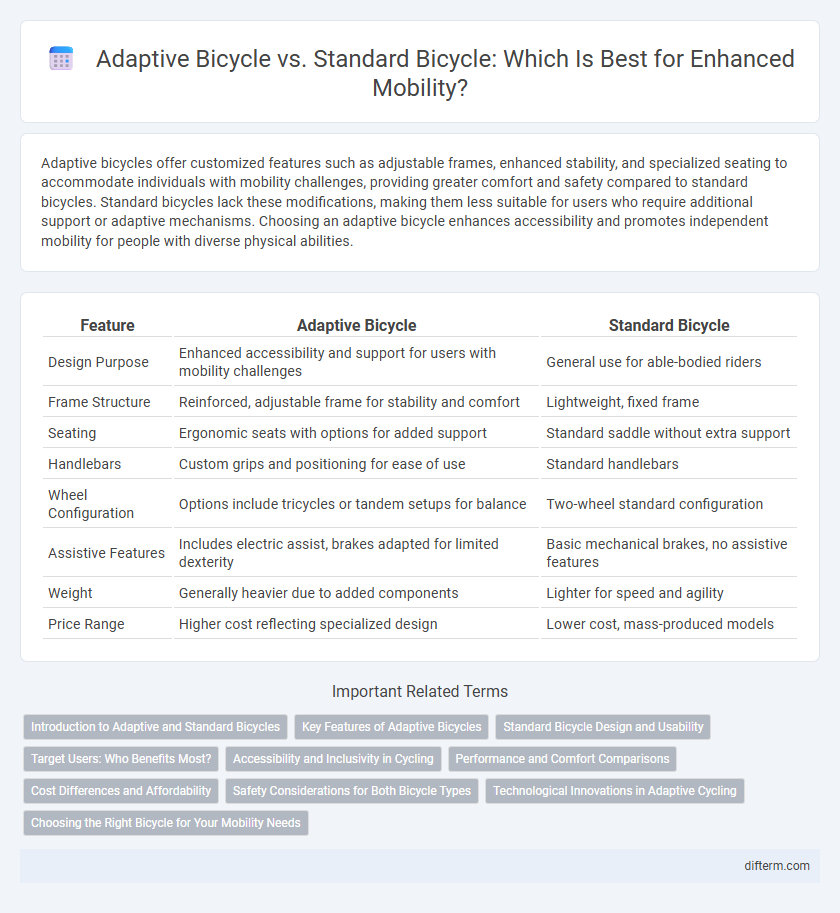Adaptive bicycles offer customized features such as adjustable frames, enhanced stability, and specialized seating to accommodate individuals with mobility challenges, providing greater comfort and safety compared to standard bicycles. Standard bicycles lack these modifications, making them less suitable for users who require additional support or adaptive mechanisms. Choosing an adaptive bicycle enhances accessibility and promotes independent mobility for people with diverse physical abilities.
Table of Comparison
| Feature | Adaptive Bicycle | Standard Bicycle |
|---|---|---|
| Design Purpose | Enhanced accessibility and support for users with mobility challenges | General use for able-bodied riders |
| Frame Structure | Reinforced, adjustable frame for stability and comfort | Lightweight, fixed frame |
| Seating | Ergonomic seats with options for added support | Standard saddle without extra support |
| Handlebars | Custom grips and positioning for ease of use | Standard handlebars |
| Wheel Configuration | Options include tricycles or tandem setups for balance | Two-wheel standard configuration |
| Assistive Features | Includes electric assist, brakes adapted for limited dexterity | Basic mechanical brakes, no assistive features |
| Weight | Generally heavier due to added components | Lighter for speed and agility |
| Price Range | Higher cost reflecting specialized design | Lower cost, mass-produced models |
Introduction to Adaptive and Standard Bicycles
Adaptive bicycles are designed to accommodate riders with physical, sensory, or cognitive disabilities by offering specialized features such as extra stability, customized seating, and hand controls. Standard bicycles cater to the general population and emphasize simplicity, lightweight frames, and increased speed for typical cycling activities. Both types of bicycles serve the purpose of mobility, but adaptive bicycles enhance accessibility and independence for individuals with diverse needs.
Key Features of Adaptive Bicycles
Adaptive bicycles feature customized designs such as specialized seating, hand controls, and enhanced stability mechanisms to accommodate users with diverse mobility needs. They often include adjustable frames, pedal modifications, and supportive harnesses to ensure comfort and safety during rides. These key features distinguish adaptive bicycles from standard models, enabling greater accessibility and independence for riders with physical disabilities.
Standard Bicycle Design and Usability
Standard bicycles feature a traditional frame geometry optimized for general use, providing a reliable balance between stability and agility. Their design includes fixed gear ratios and conventional brakes, ensuring straightforward maintenance and consistent performance across varied terrains. The familiar ergonomics and universally compatible components make standard bicycles accessible and user-friendly for riders of all skill levels.
Target Users: Who Benefits Most?
Adaptive bicycles primarily benefit individuals with physical disabilities or limited mobility, offering customized features like hand pedals, balance aids, and adjustable seating to ensure safety and comfort. Standard bicycles serve the general population seeking recreation, exercise, or commuting without specific mobility challenges. Users with unique physical needs or rehabilitation goals find the adaptive bicycle essential for independence and active lifestyle maintenance.
Accessibility and Inclusivity in Cycling
Adaptive bicycles enhance accessibility and inclusivity by providing customized features such as hand pedals, tricycles, and tandem options that accommodate various physical abilities. Standard bicycles often lack these modifications, limiting participation for riders with disabilities or mobility challenges. Incorporating adaptive bicycles into cycling programs expands opportunities for diverse users, promoting equal access and fostering a more inclusive cycling community.
Performance and Comfort Comparisons
Adaptive bicycles offer enhanced comfort through ergonomic design features such as adjustable seating, suspension systems, and customized frame geometry that reduce strain during rides. Performance improvements include better stability and control for users with varying physical abilities, enabling more efficient power transfer compared to standard bicycles. Standard bicycles typically prioritize speed and agility but lack the tailored support that adaptive models provide for prolonged, comfortable rides.
Cost Differences and Affordability
Adaptive bicycles typically involve higher upfront costs due to specialized components and customization to meet individual mobility needs, whereas standard bicycles are generally more affordable with mass-produced parts. Maintenance expenses for adaptive bicycles can also be greater, reflecting the tailored adjustments and advanced features. Budget-conscious buyers seeking mobility solutions often weigh these cost differences against the enhanced accessibility and comfort provided by adaptive bicycles.
Safety Considerations for Both Bicycle Types
Adaptive bicycles incorporate enhanced safety features such as improved stability, customized seating, and better balance support, reducing the risk of falls for riders with mobility challenges. Standard bicycles rely on conventional safety mechanisms like reflectors, brakes, and helmets, which may not fully accommodate riders with specific physical needs. Evaluating safety considerations involves assessing individual rider capabilities and the appropriate bicycle adaptations to minimize injury risks and ensure secure mobility.
Technological Innovations in Adaptive Cycling
Technological innovations in adaptive cycling include advanced sensor integration, electric assist motors, and customizable frame geometry, enhancing mobility for users with diverse physical needs. Adaptive bicycles now incorporate smart stability systems and ergonomic controls, improving safety and user comfort compared to standard bicycles. These innovations enable greater independence and accessibility, transforming adaptive cycling into a cutting-edge mobility solution.
Choosing the Right Bicycle for Your Mobility Needs
Adaptive bicycles offer tailored features such as adjustable seats, enhanced stability, and specialized controls to accommodate a variety of physical limitations, making them ideal for riders with mobility challenges. Standard bicycles, designed for typical users, prioritize speed and efficiency but lack customization for individual mobility needs. Selecting the right bicycle depends on assessing physical capabilities, comfort requirements, and intended usage to ensure safety and maximize riding enjoyment.
Adaptive bicycle vs standard bicycle Infographic

 difterm.com
difterm.com